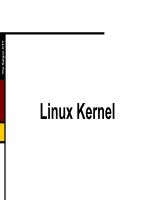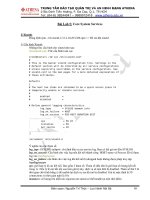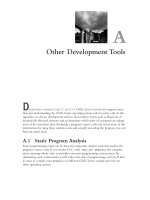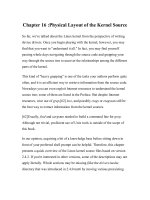Linux kernel development
Bạn đang xem bản rút gọn của tài liệu. Xem và tải ngay bản đầy đủ của tài liệu tại đây (2.44 MB, 467 trang )
Linux Kernel
Development
Third Edition
From the Library of Wow! eBook
Developer’s Library
ESSENTIAL REFERENCES FOR PROGRAMMING PROFESSIONALS
Developer’s Library books are designed to provide practicing programmers with
unique, high-quality references and tutorials on the programming languages and
technologies they use in their daily work.
All books in the Developer’s Library are written by expert technology practitioners
who are especially skilled at organizing and presenting information in a way that’s
useful for other programmers.
Key titles include some of the best, most widely acclaimed books within their
topic areas:
PHP & MySQL Web Development
Python Essential Reference
Luke Welling & Laura Thomson
ISBN 978-0-672-32916-6
David Beazley
ISBN-13: 978-0-672-32978-6
MySQL
Programming in Objective-C 2.0
Paul DuBois
ISBN-13: 978-0-672-32938-8
Stephen G. Kochan
ISBN-13: 978-0-321-56615-7
Linux Kernel Development
PostgreSQL
Robert Love
ISBN-13: 978-0-672-32946-3
Korry Douglas
ISBN-13: 978-0-672-33015-5
Developer’s Library books are available at most retail and online bookstores, as well
as by subscription from Safari Books Online at safari.informit.com
Developer’s
Library
informit.com/devlibrary
From the Library of Wow! eBook
Linux Kernel
Development
Third Edition
Robert Love
Upper Saddle River, NJ • Boston • Indianapolis • San Francisco
New York • Toronto • Montreal • London • Munich • Paris • Madrid
Cape Town • Sydney • Tokyo • Singapore • Mexico City
From the Library of Wow! eBook
Linux Kernel Development
Acquisitions Editor
Mark Taber
Third Edition
Copyright © 2010 Pearson Education, Inc.
All rights reserved. Printed in the United States of America. This publication is protected by
copyright, and permission must be obtained from the publisher prior to any prohibited reproduction, storage in a retrieval system, or transmission in any form or by any means, electronic, mechanical, photocopying, recording, or likewise.
ISBN-13: 978-0-672-32946-3
ISBN-10: 0-672-32946-8
Development
Editor
Michael Thurston
Technical Editor
Robert P. J. Day
Managing Editor
Sandra Schroeder
Senior Project
Editor
Tonya Simpson
Library of Congress Cataloging-in-Publication Data:
Love, Robert.
Copy Editor
Apostrophe Editing
Services
Linux kernel development / Robert Love. — 3rd ed.
p. cm.
Indexer
Brad Herriman
Includes bibliographical references and index.
ISBN 978-0-672-32946-3 (pbk. : alk. paper) 1. Linux. 2. Operating systems (Computers)
I. Title.
Proofreader
Debbie Williams
Publishing
Coordinator
Vanessa Evans
QA76.76.O63L674 2010
005.4’32—dc22
2010018961
Text printed in the United States on recycled paper at RR Donnelley, Crawfordsville, Indiana.
First printing June 2010
Book Designer
Gary Adair
Compositor
Mark Shirar
Many of the designations used by manufacturers and sellers to distinguish their products
are claimed as trademarks. Where those designations appear in this book, and the publisher was aware of a trademark claim, the designations have been printed with initial capital
letters or in all capitals.
The author and publisher have taken care in the preparation of this book, but make no
expressed or implied warranty of any kind and assume no responsibility for errors or omissions. No liability is assumed for incidental or consequential damages in connection with or
arising out of the use of the information or programs contained herein.
The publisher offers excellent discounts on this book when ordered in quantity for bulk purchases or special sales, which may include electronic versions and/or custom covers and
content particular to your business, training goals, marketing focus, and branding interests.
For more information, please contact:
U.S. Corporate and Government Sales
(800) 382-3419
For sales outside the United States please contact:
International Sales
Visit us on the Web: informit.com/aw
From the Library of Wow! eBook
❖
For Doris and Helen.
❖
From the Library of Wow! eBook
Contents at a Glance
1 Introduction to the Linux Kernel
1
2 Getting Started with the Kernel
11
3 Process Management
4 Process Scheduling
5 System Calls
23
41
69
6 Kernel Data Structures
85
7 Interrupts and Interrupt Handlers
113
8 Bottom Halves and Deferring Work
133
9 An Introduction to Kernel Synchronization
10 Kernel Synchronization Methods
11 Timers and Time Management
12 Memory Management
231
13 The Virtual Filesystem
261
14 The Block I/O Layer
175
207
289
15 The Process Address Space
305
16 The Page Cache and Page Writeback
17 Devices and Modules
18 Debugging
363
19 Portability
379
Index
323
337
20 Patches, Hacking, and the Community
Bibliography
161
395
407
411
From the Library of Wow! eBook
Table of Contents
1 Introduction to the Linux Kernel
History of Unix
1
1
Along Came Linus: Introduction to Linux
3
Overview of Operating Systems and Kernels
Linux Versus Classic Unix Kernels
Linux Kernel Versions
8
The Linux Kernel Development Community
Before We Begin
Obtaining the Kernel Source
11
11
11
Installing the Kernel Source
Using Patches
Building the Kernel
12
12
The Kernel Source Tree
12
13
Configuring the Kernel
14
Minimizing Build Noise
15
Spawning Multiple Build Jobs
Installing the New Kernel
16
16
A Beast of a Different Nature
16
No libc or Standard Headers
GNU C
10
10
2 Getting Started with the Kernel
Using Git
4
6
17
18
Inline Functions
18
Inline Assembly
19
Branch Annotation
19
No Memory Protection
20
No (Easy) Use of Floating Point
Small, Fixed-Size Stack
Synchronization and Concurrency
Importance of Portability
Conclusion
20
20
21
21
21
From the Library of Wow! eBook
viii
Contents
3 Process Management
The Process
23
23
Process Descriptor and the Task Structure
Allocating the Process Descriptor
Storing the Process Descriptor
Process State
25
26
27
Manipulating the Current Process State
Process Context
Process Creation
31
Copy-on-Write
31
29
32
vfork()
33
The Linux Implementation of Threads
Creating Threads
Kernel Threads
33
34
35
Process Termination
36
Removing the Process Descriptor
37
The Dilemma of the Parentless Task
Conclusion
41
41
Linux’s Process Scheduler
Policy
38
40
4 Process Scheduling
Multitasking
29
29
The Process Family Tree
Forking
24
42
43
I/O-Bound Versus Processor-Bound Processes
Process Priority
Timeslice
43
44
45
The Scheduling Policy in Action
The Linux Scheduling Algorithm
Scheduler Classes
45
46
46
Process Scheduling in Unix Systems
Fair Scheduling
The Linux Scheduling Implementation
Time Accounting
47
48
50
50
The Scheduler Entity Structure
The Virtual Runtime
50
51
From the Library of Wow! eBook
Contents
Process Selection
52
Picking the Next Task
53
Adding Processes to the Tree
54
Removing Processes from the Tree
The Scheduler Entry Point
Waking Up
56
57
Sleeping and Waking Up
Wait Queues
ix
58
58
61
Preemption and Context Switching
User Preemption
Kernel Preemption
62
62
63
Real-Time Scheduling Policies
64
Scheduler-Related System Calls
65
Scheduling Policy and Priority-Related
System Calls 66
Processor Affinity System Calls
Yielding Processor Time
Conclusion
67
5 System Calls
69
Communicating with the Kernel
APIs, POSIX, and the C Library
Syscalls
66
66
69
70
71
System Call Numbers
72
System Call Performance
System Call Handler
72
73
Denoting the Correct System Call
Parameter Passing
System Call Implementation
74
Implementing System Calls
Verifying the Parameters
System Call Context
73
74
74
75
78
Final Steps in Binding a System Call
79
Accessing the System Call from User-Space
Why Not to Implement a System Call
Conclusion
81
82
83
From the Library of Wow! eBook
x
Contents
6 Kernel Data Structures
Linked Lists
85
85
Singly and Doubly Linked Lists
Circular Linked Lists
85
86
Moving Through a Linked List
87
The Linux Kernel’s Implementation
The Linked List Structure
Defining a Linked List
List Heads
88
88
89
90
Manipulating Linked Lists
90
Adding a Node to a Linked List
90
Deleting a Node from a Linked List
91
Moving and Splicing Linked List Nodes
Traversing Linked Lists
93
The Basic Approach
93
The Usable Approach
93
Iterating Through a List Backward
Iterating While Removing
Other Linked List Methods
Queues
96
kfifo
97
Creating a Queue
94
95
96
97
Enqueuing Data
98
Dequeuing Data
98
Obtaining the Size of a Queue
98
Resetting and Destroying the Queue
Example Queue Usage
Maps
92
99
99
100
Initializing an idr
101
Allocating a New UID
Looking Up a UID
Removing a UID
103
Destroying an idr
Binary Trees
101
102
103
103
Binary Search Trees
104
Self-Balancing Binary Search Trees
Red-Black Trees
rbtrees
105
105
106
From the Library of Wow! eBook
Contents
What Data Structure to Use, When
Algorithmic Complexity
Algorithms
108
109
109
Big-O Notation
109
Big Theta Notation
Time Complexity
Conclusion
109
110
111
7 Interrupts and Interrupt Handlers
Interrupts
xi
113
113
Interrupt Handlers
114
Top Halves Versus Bottom Halves
115
Registering an Interrupt Handler
Interrupt Handler Flags
116
116
An Interrupt Example
117
Freeing an Interrupt Handler
Writing an Interrupt Handler
Shared Handlers
118
118
119
A Real-Life Interrupt Handler
Interrupt Context
120
122
Implementing Interrupt Handlers
/proc/interrupts
Interrupt Control
123
126
127
Disabling and Enabling Interrupts
127
Disabling a Specific Interrupt Line
129
Status of the Interrupt System
Conclusion
130
131
8 Bottom Halves and Deferring Work
Bottom Halves
133
134
Why Bottom Halves?
134
A World of Bottom Halves
135
The Original “Bottom Half”
Task Queues
135
135
Softirqs and Tasklets
136
Dispelling the Confusion
137
From the Library of Wow! eBook
xii
Contents
Softirqs
137
Implementing Softirqs
137
The Softirq Handler
138
Executing Softirqs
Using Softirqs
138
140
Assigning an Index
140
Registering Your Handler
Raising Your Softirq
Tasklets
141
141
142
Implementing Tasklets
142
The Tasklet Structure
Scheduling Tasklets
Using Tasklets
142
143
144
Declaring Your Tasklet
144
Writing Your Tasklet Handler
Scheduling Your Tasklet
ksoftirqd
145
146
The Old BH Mechanism
Work Queues
145
148
149
Implementing Work Queues
149
Data Structures Representing the Threads
Data Structures Representing the Work
Work Queue Implementation Summary
Using Work Queues
Creating Work
153
Scheduling Work
153
153
154
Creating New Work Queues
154
The Old Task Queue Mechanism
Which Bottom Half Should I Use?
155
156
Locking Between the Bottom Halves
Disabling Bottom Halves
Conclusion
150
152
153
Your Work Queue Handler
Flushing Work
149
157
157
159
9 An Introduction to Kernel Synchronization
Critical Regions and Race Conditions
Why Do We Need Protection?
The Single Variable
161
162
162
163
From the Library of Wow! eBook
Contents
Locking
xiii
165
Causes of Concurrency
167
Knowing What to Protect
Deadlocks
168
169
Contention and Scalability
Conclusion
171
172
10 Kernel Synchronization Methods
Atomic Operations
Atomic Integer Operations
176
64-Bit Atomic Operations
180
Atomic Bitwise Operations
Spin Locks
175
175
181
183
Spin Lock Methods
184
Other Spin Lock Methods
186
Spin Locks and Bottom Halves
Reader-Writer Spin Locks
Semaphores
187
188
190
Counting and Binary Semaphores
191
Creating and Initializing Semaphores
Using Semaphores
Reader-Writer Semaphores
Mutexes
194
195
Semaphores Versus Mutexes
Spin Locks Versus Mutexes
Completion Variables
Sequential Locks
197
197
197
BKL: The Big Kernel Lock
198
200
Preemption Disabling
201
Ordering and Barriers
203
Conclusion
192
193
206
11 Timers and Time Management
Kernel Notion of Time
The Tick Rate: HZ
207
208
208
The Ideal HZ Value
210
Advantages with a Larger HZ
210
Disadvantages with a Larger HZ
211
From the Library of Wow! eBook
xiv
Contents
Jiffies
212
Internal Representation of Jiffies
Jiffies Wraparound
214
User-Space and HZ
216
Hardware Clocks and Timers
Real-Time Clock
System Timer
216
217
217
The Timer Interrupt Handler
The Time of Day
Timers
213
217
220
222
Using Timers
222
Timer Race Conditions
Timer Implementation
Delaying Execution
224
224
225
Busy Looping
225
Small Delays
226
227
schedule_timeout()
schedule_timeout() Implementation
228
Sleeping on a Wait Queue, with a Timeout
Conclusion
230
12 Memory Management
Pages
231
Zones
233
Getting Pages
231
235
Getting Zeroed Pages
Freeing Pages
kmalloc()
236
237
238
gfp_mask Flags
238
Action Modifiers
Zone Modifiers
Type Flags
kfree()
229
239
240
241
243
vmalloc()
244
Slab Layer
245
Design of the Slab Layer
246
From the Library of Wow! eBook
Contents
Slab Allocator Interface
249
Allocating from the Cache
250
Example of Using the Slab Allocator
Statically Allocating on the Stack
Single-Page Kernel Stacks
Playing Fair on the Stack
High Memory Mappings
252
253
253
254
Temporary Mappings
254
255
The New percpu Interface
256
Per-CPU Data at Compile-Time
Per-CPU Data at Runtime
256
257
Reasons for Using Per-CPU Data
Picking an Allocation Method
Conclusion
251
252
Permanent Mappings
Per-CPU Allocations
258
259
260
13 The Virtual Filesystem
261
Common Filesystem Interface
Filesystem Abstraction Layer
Unix Filesystems
261
262
263
VFS Objects and Their Data Structures
The Superblock Object
266
Superblock Operations
267
The Inode Object
270
Inode Operations
271
The Dentry Object
Dentry State
265
275
276
The Dentry Cache
Dentry Operations
276
278
The File Object
279
File Operations
280
Data Structures Associated with Filesystems
Data Structures Associated with a Process
Conclusion
xv
285
286
288
From the Library of Wow! eBook
xvi
Contents
14 The Block I/O Layer
289
Anatomy of a Block Device
Buffers and Buffer Heads
The bio Structure
I/O vectors
290
291
294
295
The Old Versus the New
Request Queues
296
297
I/O Schedulers
297
The Job of an I/O Scheduler
The Linus Elevator
298
299
The Deadline I/O Scheduler
300
The Anticipatory I/O Scheduler
302
The Complete Fair Queuing I/O Scheduler
The Noop I/O Scheduler
303
I/O Scheduler Selection
304
Conclusion
303
304
15 The Process Address Space
Address Spaces
305
305
The Memory Descriptor
306
Allocating a Memory Descriptor
Destroying a Memory Descriptor
308
309
The mm_struct and Kernel Threads
Virtual Memory Areas
VMA Flags
309
309
311
VMA Operations
312
Lists and Trees of Memory Areas
Memory Areas in Real Life
Manipulating Memory Areas
find_vma()
313
314
315
316
find_vma_prev()
317
find_vma_intersection()
317
mmap() and do_mmap(): Creating an
Address Interval
318
munmap() and do_munmap(): Removing an
Address Interval
Page Tables
Conclusion
320
320
322
From the Library of Wow! eBook
Contents
16 The Page Cache and Page Writeback
Approaches to Caching
Write Caching
323
323
324
Cache Eviction
324
Least Recently Used
325
The Two-List Strategy
325
The Linux Page Cache
326
The address_space Object
326
address_space Operations
328
Radix Tree
330
The Old Page Hash Table
The Buffer Cache
330
330
The Flusher Threads
Laptop Mode
331
333
History: bdflush, kupdated, and pdflush
333
Avoiding Congestion with Multiple Threads
Conclusion
Device Types
337
337
338
Hello, World!
338
Building Modules
340
Living in the Source Tree
Living Externally
342
Installing Modules
342
340
Generating Module Dependencies
Loading Modules
Module Parameters
Exported Symbols
The Device Model
Kobjects
Ksets
342
343
Managing Configuration Options
Ktypes
334
335
17 Devices and Modules
Modules
xvii
344
346
348
348
349
350
351
Interrelation of Kobjects, Ktypes, and Ksets
Managing and Manipulating Kobjects
351
352
From the Library of Wow! eBook
xviii
Contents
Reference Counts
353
Incrementing and Decrementing
Reference Counts 354
Krefs
sysfs
354
355
Adding and Removing kobjects from sysfs
Adding Files to sysfs
358
Default Attributes
358
Creating New Attributes
Destroying Attributes
sysfs Conventions
18 Debugging
359
360
360
The Kernel Events Layer
Conclusion
361
362
363
Getting Started
363
Bugs in the Kernel
364
Debugging by Printing
Robustness
Loglevels
364
365
365
The Log Buffer
366
syslogd and klogd
367
Transposing printf() and printk()
Oops
357
367
367
ksymoops
369
kallsyms
369
Kernel Debugging Options
370
Asserting Bugs and Dumping Information
Magic SysRq Key
371
The Saga of a Kernel Debugger
gdb
kgdb
370
372
372
373
Poking and Probing the System
Using UID as a Conditional
Using Condition Variables
Using Statistics
373
373
374
374
Rate and Occurrence Limiting Your Debugging
375
From the Library of Wow! eBook
Contents
Binary Searching to Find the Culprit Change
Binary Searching with Git
378
19 Portability
379
Portable Operating Systems
Word Size and Data Types
384
Special Types
384
380
381
Explicitly Sized Types
385
Signedness of Chars
386
Data Alignment
386
Avoiding Alignment Issues
387
Alignment of Nonstandard Types
Structure Padding
Byte Order
Time
377
379
History of Portability in Linux
Opaque Types
376
376
When All Else Fails: The Community
Conclusion
xix
387
387
389
391
Page Size
391
Processor Ordering
392
SMP, Kernel Preemption, and High Memory
Conclusion
20 Patches, Hacking, and the Community
The Community
Indention
395
395
Linux Coding Style
396
396
Switch Statements
Spacing
Braces
393
393
396
397
398
Line Length
Naming
400
Functions
Comments
Typedefs
399
400
400
401
Use Existing Routines
402
From the Library of Wow! eBook
xx
Contents
Minimize ifdefs in the Source
Structure Initializers
402
Fixing Up Code Ex Post Facto
Chain of Command
403
404
Generating Patches
404
Generating Patches with Git
Submitting Patches
Conclusion
Bibliography
Index
403
403
Submitting Bug Reports
Patches
402
405
406
406
407
411
From the Library of Wow! eBook
Foreword
A
s the Linux kernel and the applications that use it become more widely used, we are
seeing an increasing number of system software developers who wish to become involved
in the development and maintenance of Linux. Some of these engineers are motivated
purely by personal interest, some work for Linux companies, some work for hardware
manufacturers, and some are involved with in-house development projects.
But all face a common problem:The learning curve for the kernel is getting longer
and steeper.The system is becoming increasingly complex, and it is very large. And as the
years pass, the current members of the kernel development team gain deeper and broader
knowledge of the kernel’s internals, which widens the gap between them and newcomers.
I believe that this declining accessibility of the Linux source base is already a problem
for the quality of the kernel, and it will become more serious over time.Those who care
for Linux clearly have an interest in increasing the number of developers who can contribute to the kernel.
One approach to this problem is to keep the code clean: sensible interfaces, consistent
layout, “do one thing, do it well,” and so on.This is Linus Torvalds’ solution.
The approach that I counsel is to liberally apply commentary to the code: words that
the reader can use to understand what the coder intended to achieve at the time. (The
process of identifying divergences between the intent and the implementation is known
as debugging. It is hard to do this if the intent is not known.)
But even code commentary does not provide the broad-sweep view of what a major
subsystem is intended to do, and of how its developers set about doing it.This, the starting point of understanding, is what the written word serves best.
Robert Love’s contribution provides a means by which experienced developers can
gain that essential view of what services the kernel subsystems are supposed to provide,
and of how they set about providing them.This will be sufficient knowledge for many
people: the curious, the application developers, those who wish to evaluate the kernel’s
design, and others.
But the book is also a stepping stone to take aspiring kernel developers to the next
stage, which is making alterations to the kernel to achieve some defined objective. I
would encourage aspiring developers to get their hands dirty:The best way to understand a part of the kernel is to make changes to it. Making a change forces the developer
to a level of understanding which merely reading the code does not provide.The serious
kernel developer will join the development mailing lists and will interact with other
developers.This interaction is the primary means by which kernel contributors learn
From the Library of Wow! eBook
and stay abreast. Robert covers the mechanics and culture of this important part of
kernel life well.
Please enjoy and learn from Robert’s book. And should you decide to take the next
step and become a member of the kernel development community, consider yourself
welcomed in advance.We value and measure people by the usefulness of their contributions, and when you contribute to Linux, you do so in the knowledge that your work is
of small but immediate benefit to tens or even hundreds of millions of human beings.
This is a most enjoyable privilege and responsibility.
Andrew Morton
From the Library of Wow! eBook
Preface
W
hen I was first approached about converting my experiences with the Linux kernel
into a book, I proceeded with trepidation.What would place my book at the top of its
subject? I was not interested unless I could do something special, a best-in-class work.
I realized that I could offer a unique approach to the topic. My job is hacking the kernel.
My hobby is hacking the kernel. My love is hacking the kernel. Over the years, I have accumulated interesting anecdotes and insider tips.With my experiences, I could write a book on
how to hack the kernel and—just as important—how not to hack the kernel. First and foremost, this is a book about the design and implementation of the Linux kernel.This book’s
approach differs from would-be competitors, however, in that the information is given with
a slant to learning enough to actually get work done—and getting it done right. I am a
pragmatic engineer and this is a practical book. It should be fun, easy to read, and useful.
I hope that readers can walk away from this work with a better understanding of the
rules (written and unwritten) of the Linux kernel. I intend that you, fresh from reading
this book and the kernel source code, can jump in and start writing useful, correct, clean
kernel code. Of course, you can read this book just for fun, too.
That was the first edition.Time has passed, and now we return once more to the fray.
This third edition offers quite a bit over the first and second: intense polish and revision,
updates, and many fresh sections and all new chapters.This edition incorporates changes in
the kernel since the second edition. More important, however, is the decision made by the
Linux kernel community to not proceed with a 2.7 development kernel in the near to midterm.1 Instead, kernel developers plan to continue developing and stabilizing the 2.6 series.
This decision has many implications, but the item of relevance to this book is that there is
quite a bit of staying power in a contemporary book on the 2.6 Linux kernel.As the Linux
kernel matures, there is a greater chance of a snapshot of the kernel remaining representative
long into the future.This book functions as the canonical documentation for the kernel,
documenting it with both an understanding of its history and an eye to the future.
Using This Book
Developing code in the kernel does not require genius, magic, or a bushy Unix-hacker
beard.The kernel, although having some interesting rules of its own, is not much different from any other large software endeavor.You need to master many details—as with
any big project—but the differences are quantitative, not qualitative.
This decision was made in the summer of 2004 at the annual Linux Kernel Developers Summit in
Ottawa, Canada. Your author was an invited attendee.
1
From the Library of Wow! eBook
It is imperative that you utilize the source.The open availability of the source code
for the Linux system is a rare gift that you must not take for granted. It is not sufficient
only to read the source, however.You need to dig in and change some code. Find a bug
and fix it. Improve the drivers for your hardware. Add some new functionality, even if it
is trivial. Find an itch and scratch it! Only when you write code will it all come together.
Kernel Version
This book is based on the 2.6 Linux kernel series. It does not cover older kernels, except
for historical relevance.We discuss, for example, how certain subsystems are implemented
in the 2.4 Linux kernel series, as their simpler implementations are helpful teaching aids.
Specifically, this book is up to date as of Linux kernel version 2.6.34. Although the kernel is a moving target and no effort can hope to capture such a dynamic beast in a timeless manner, my intention is that this book is relevant for developers and users of both
older and newer kernels.
Although this book discusses the 2.6.34 kernel, I have made an effort to ensure the
material is factually correct with respect to the 2.6.32 kernel as well.That latter version
is sanctioned as the “enterprise” kernel by the various Linux distributions, ensuring we
will continue to see it in production systems and under active development for many
years. (2.6.9, 2.6.18, and 2.6.27 were similar “long-term” releases.)
Audience
This book targets Linux developers and users who are interested in understanding the
Linux kernel. It is not a line-by-line commentary of the kernel source. Nor is it a guide
to developing drivers or a reference on the kernel API. Instead, the goal of this book is
to provide enough information on the design and implementation of the Linux kernel
that a sufficiently accomplished programmer can begin developing code in the kernel.
Kernel development can be fun and rewarding, and I want to introduce the reader to
that world as readily as possible.This book, however, in discussing both theory and application, should appeal to readers of both academic and practical persuasions. I have always
been of the mind that one needs to understand the theory to understand the application,
but I try to balance the two in this work. I hope that whatever your motivations for
understanding the Linux kernel, this book explains the design and implementation sufficiently for your needs.
Thus, this book covers both the usage of core kernel systems and their design and
implementation. I think this is important and deserves a moment’s discussion. A good
example is Chapter 8, “Bottom Halves and Deferring Work,” which covers a component
of device drivers called bottom halves. In that chapter, I discuss both the design and
implementation of the kernel’s bottom-half mechanisms (which a core kernel developer
or academic might find interesting) and how to actually use the exported interfaces to
implement your own bottom half (which a device driver developer or casual hacker can
find pertinent). I believe all groups can find both discussions relevant.The core kernel
From the Library of Wow! eBook









